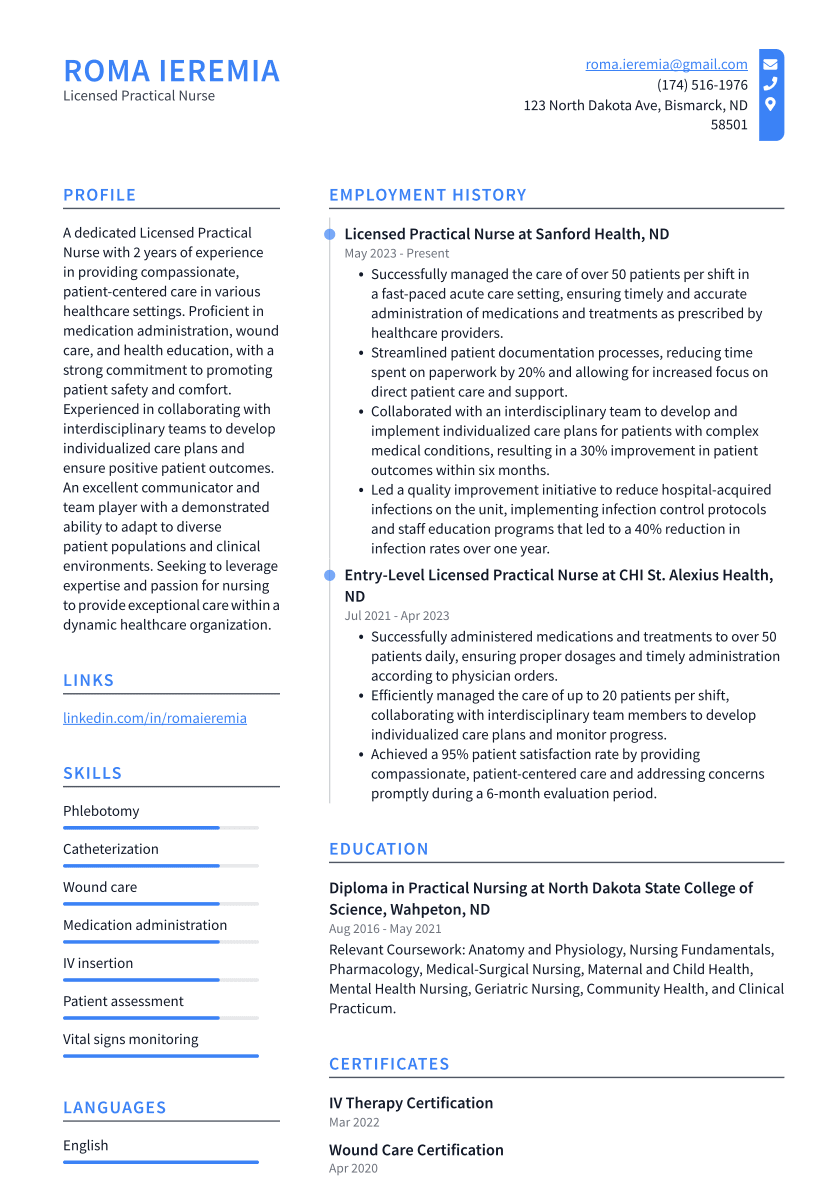Licensed Practical Nurse Resume Examples
Writing a great licensed practical nurse resume is important because it is one of the first things a potential employer will see when they are considering you for a position. It is your opportunity to make a good first impression and sell yourself as the best candidate for the job.
Create your resume
Select from 7 professional resume templates
If you're looking for inspiration when it comes to drafting your own licensed practical nurse resume, look no further than the samples below. These resumes will help you highlight your experience and qualifications in the most effective way possible, giving you the best chance of landing the licensed practical nurse job you're after.
Essential Components of a Licensed Practical Nurse Resume
A resume for a Licensed Practical Nurse (LPN) is a critical tool in your job search arsenal. It showcases your nursing expertise, professional history, and credentials, serving as your representative to prospective employers. Crafting a standout resume involves highlighting your distinct qualities, organizing the content effectively, and tailoring it to the LPN position you're targeting. This guide will delve into the essential sections of an LPN resume, discuss their significance, and offer tips to make your resume compelling to hiring managers.
1. Contact Information
Your Contact Information should be prominently placed at the top of your resume, making it simple for potential employers to reach out to you. Include your full name, address, phone number, and a professional email address. Ensure these details are current and accurate. A professional email typically includes your first and last name, and it's crucial to avoid using unprofessional handles.

Consider adding your LinkedIn profile or professional website if relevant, as these can further demonstrate your nursing expertise and professional connections.
- LinkedIn Profile: Useful for showcasing your professional network and endorsements.
- Online Portfolio: Can include case studies or research pertinent to nursing.
Remember to omit personal details such as marital status, age, or social security number from this section.
2. Objective Statement
The Objective Statement is a concise introduction that outlines your career aspirations and intentions within the nursing field. It should be brief, clear, and tailored to the LPN role you're applying for. Highlight your skills, experiences, and qualifications that align with the job, and express your commitment to contributing to the healthcare facility.
An example of an effective objective statement might be: "Committed Licensed Practical Nurse seeking to leverage extensive experience in geriatric care to enhance patient outcomes at Sunshine Health Facility."
While the objective statement sets the tone for your resume, it should complement, not overshadow, the subsequent sections detailing your work history, education, and certifications.
3. Skills and Competencies
The Skills and Competencies section is where you list your nursing-specific abilities and knowledge. Include both hard skills, such as clinical tasks and technical proficiencies, and soft skills, like communication and empathy.
Hard Skills:
- Administering medication
- Wound care
- Monitoring vital signs
- Performing routine lab tests
Soft Skills:
- Effective communication
- Empathy and emotional support
- Attention to detail
- Critical thinking
Provide examples of how you've applied these skills in practice to give employers a clear picture of your capabilities.
4. Work Experience
The Work Experience section chronicles your professional journey as an LPN. List your roles in reverse chronological order, including the employer, job title, dates of employment, and location. Use bullet points to describe your responsibilities and achievements, and quantify them when possible. Highlight any areas of specialization and instances where you demonstrated leadership or initiative.
Remember to respect patient confidentiality and avoid disclosing sensitive information about previous workplaces.
5. Education and Certifications
In the Education and Certifications section, list your nursing degree or diploma from an accredited program, along with any additional training or certifications that are relevant to the LPN role. Certifications such as IV Therapy, Geriatric Care, or Long-Term Care should be included here, as well as CPR or BLS certifications.
Also, detail any state licenses you hold, including license numbers and expiration dates, to affirm your eligibility to practice as an LPN.
6. Licenses and Registrations
The Licenses and Registrations section is crucial, as it verifies your legal qualification to work as an LPN. List all relevant licenses and registrations, ensuring the information is up-to-date. Include any additional certifications that enhance your professional profile, such as ACLS or PALS, and provide registration numbers where applicable.
Accuracy is paramount in this section, as employers may verify these details during the hiring process.
7. Professional References
Professional References can significantly bolster your LPN resume by providing potential employers with insights into your professional conduct and nursing competencies. Select references who can confidently speak to your abilities, such as former supervisors or colleagues. Obtain their consent before listing them and include their full names, job titles, relationship to you, and contact information.
Quality references can enhance your job prospects, so choose individuals who will provide positive and honest feedback about your professional nursing practice.
By carefully crafting each section of your LPN resume, you can present a comprehensive and professional image to potential employers, increasing your chances of securing the nursing position you desire.
